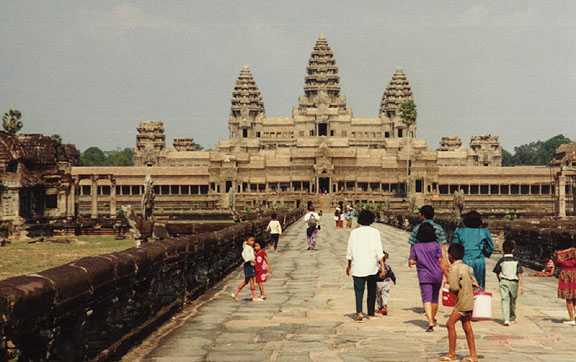

Angkor Wat

entrance
Angkor Wat, renowned Hindu temple complex at Ângkôr, the region that served from 802 until 1295 as the capital of the Khmer Empire of Cambodia, now a destination for Buddhist pilgrims. Built for King Suryavarman II in the 12th century, Angkor Wat is the most famous temple in Cambodia and is probably the largest religious monument ever constructed.
the complex
The complex, built of both sandstone and laterite (a dense, porous, iron-bearing soil that can be quarried like stone), forms a rectangle of about 850 m by 1000 m (2800 by 3800 ft). It was constructed to serve both as a sepulchre for Suryavarman II, whose regime had adopted some aspects of Hinduism, and as a celebration of his status as an incarnation of the Hindu god Vishnu.
as seen across a pond
(now dry with grass growing)As a sepulchre the temple was built facing west (the direction taken by the dead in going to their next life, in Hindu belief), rather than facing east, which was traditional for Hindu temples. Taking more than 30 years to build, the layout of the complex was conceived as an architectural allegory of the Hindu cosmology (world concept). At the center of the complex stands a temple with five lotus-shaped towers, a larger central tower, and four smaller surrounding towers.
detail
These represent the five peaks of Mount Meru—according to Hindu belief, the mountain where the gods reside and from which all creation comes. The central tower enclosure is surrounded by three square, terraced enclosures that rise toward the central towers.
The series of terraces symbolizes the mountain ranges that in Hindu cosmology surround the habitable world. The entire complex is surrounded by a moat over 5 km in length, representing the primordial ocean, over which extends an elaborate 475-m causeway, leading to the main of four gateways into the temple complex.
The causeway was decorated on each side with carvings depicting the divine serpents, known as nagas.
interior hallway with bas-reliefs
Angkor Wat is famous for having the longest running bas-relief in the world. Beautifully crafted, many of the carvings were once painted and gilded. They decorate the 2-m high, galleried walls having roofed walkways that run along the inside of the protective moat, just outside of the temple complex itself.
The reliefs depict historical episodes in the life of King Suryavarman II; scenes from the Hindu epics the Ramayana and the Mahabharata; the exploits of the Hindu gods Shiva and Vishnu with celestial nymphs known as apsarases; and scenes from the daily life of the Khmer people at the time the complex was built.
Some of Angkor Wat's bas-reliefs suffered damage at the height of Cambodia's Khmer Rouge movement in the 1960s and 1970s.
head of Buddha
(this type of sculpture was often broken off
and sold by Khmer Rouge to support their efforts)
shrine next to reclining Buddha
Angkor Wat fell to the Cham army from northern Cambodia in 1177, after which the complex proper began to fall into ruin. It was then reclaimed, though not inhabited, by Khmer King Jayavarman VII when he defeated the Chams soon after the beginning of his reign in 1181.
Both Angkor Wat and Angkor Thum, Jayavarman VII's royal city to the north, were altered by subsequent inhabitants.
Pillaged by Thai invaders in the 15th century, they were expanded by later rulers of Cambodia, some of whom replaced existing aspects altogether. In the 1400s the Ângkôr area was abandoned as a political capital for reasons of security and, after the Thai invasion of 1431, was not permanently inhabited as a capital again.
Angkor Wat was intermittently inhabited by Buddhist monks, and about 1550 portions of its bas-reliefs were finally completed. It subsequently became a destination for Buddhist pilgrims from all over the world.
restoration work by Indian technicians
(controversial because of some of the cleaning methods used)
![]()
![]()